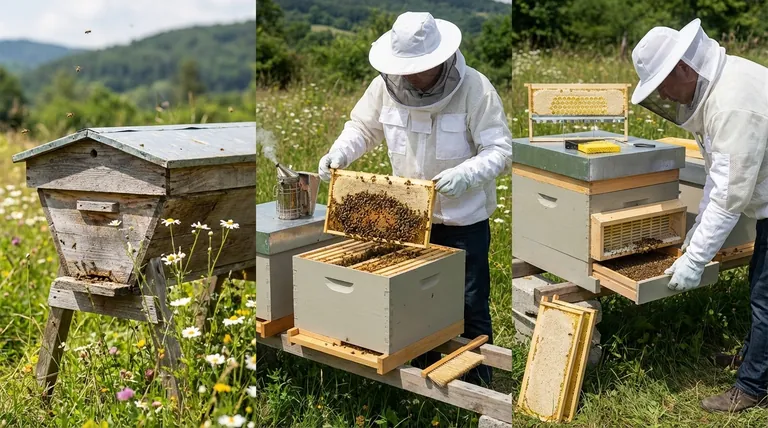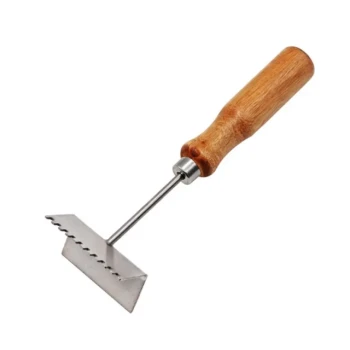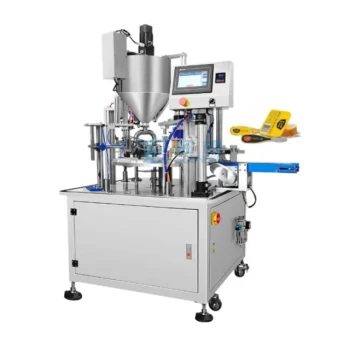In beekeeping, there are three common levels of hive maintenance: low, regular, and intensive. The level you choose is defined by your specific goals, dictating how often you interact with the colony and what products you intend to harvest.
The fundamental difference between maintenance levels is not about doing more or less work, but about aligning your actions with a specific outcome—whether it's pollination, honey production, or the commercial harvesting of specialized bee products.

Level 1: Low-Maintenance Beekeeping
Low-maintenance beekeeping, often associated with a "hands-off" or treatment-free philosophy, prioritizes the natural cycle of the colony over production yields.
Core Philosophy
The primary goal here is to support bees as pollinators and as a natural part of the ecosystem. Intervention is kept to an absolute minimum to allow the colony to manage its own health, pests, and resources.
Typical Activities
Inspections are infrequent, perhaps only a few times a year. The beekeeper checks for catastrophic issues like disease outbreaks or to ensure the colony has enough space for winter, but otherwise leaves the bees alone. Honey harvesting is rare and minimal.
Best Suited For
This approach is ideal for individuals focused on pollination for a garden or farm, conservation, or those who wish to observe bees with the least possible interference.
Level 2: Regular-Maintenance Beekeeping
This is the most common approach for hobbyist and sideline beekeepers. It represents a balance between supporting the colony's health and harvesting a sustainable surplus.
Core Philosophy
The goal is a healthy, productive hive that yields a reliable harvest of honey and beeswax. The beekeeper acts as a steward, actively managing the colony to prevent common problems and optimize production.
Typical Activities
This level involves weekly or bi-weekly inspections during the peak season. The beekeeper checks for signs of pests like varroa mites, looks for the queen's laying pattern, manages space to prevent swarming, and adds or removes honey supers as needed.
Best Suited For
This is the standard for most backyard beekeepers whose primary goal is to produce their own honey and wax while maintaining robust, healthy colonies.
Level 3: Intensive-Maintenance Beekeeping
Intensive maintenance is a highly specialized and demanding approach almost exclusively used in commercial operations focused on specific, high-value hive products.
Core Philosophy
The objective is to maximize the harvest of a particular product beyond honey, such as pollen, propolis, or royal jelly. This requires precise timing and manipulation of the colony's natural behavior.
Typical Activities
Intervention is extremely frequent, often every two to three days. This can involve installing pollen traps, specialized queen-rearing setups for royal jelly, or other equipment that requires constant monitoring and collection.
Best Suited For
This is reserved for commercial beekeepers with specialized knowledge and a market for products like royal jelly or bee pollen, which command a higher price but require significant labor and expertise.
Understanding the Trade-offs
Choosing a maintenance level involves balancing effort with risk and reward. Each approach has inherent compromises.
The Risk of Too Little Intervention
A low-maintenance approach increases the risk of losing a colony to treatable issues. A pest infestation, disease, or a sudden queen failure can go unnoticed until it's too late to save the hive.
The Stress of Too Much Intervention
Intensive management can put significant stress on a honey bee colony. Frequent openings of the hive disrupt temperature regulation, break propolis seals, and can agitate the bees, potentially making them more susceptible to disease.
The Demands of a Balanced Approach
Regular maintenance is a happy medium for most, but it requires consistency. Missing a few key inspections during a nectar flow can result in a lost swarm and a significantly reduced honey harvest.
Choosing the Right Approach for Your Apiary
Your beekeeping goals should be the sole factor in determining your maintenance style.
- If your primary focus is pollination or conservation: A low-maintenance approach allows the bees to exist as naturally as possible with minimal interference.
- If your primary focus is a sustainable honey and beeswax harvest: Regular maintenance provides the necessary oversight to ensure colony health and reliable production.
- If your primary focus is commercial production of pollen or royal jelly: Intensive management is required to maximize the yield of these specialized products.
Ultimately, successful beekeeping comes from clearly defining your purpose and applying the level of care that best serves that goal.
Summary Table:
| Maintenance Level | Primary Goal | Inspection Frequency | Ideal For |
|---|---|---|---|
| Low | Pollination & Conservation | A few times per year | Garden/farm pollination, conservationists |
| Regular | Sustainable Honey & Beeswax | Weekly or bi-weekly | Hobbyist & sideline beekeepers |
| Intensive | Max. Yield (Pollen, Royal Jelly) | Every 2-3 days | Commercial beekeepers, specialized operations |
Ready to equip your apiary for any maintenance level? HONESTBEE supplies durable, high-performance beekeeping supplies and equipment to commercial apiaries and distributors. Whether you're scaling a regular honey operation or managing an intensive royal jelly harvest, our wholesale-focused operations provide the reliable gear you need to succeed. Contact our experts today to discuss your specific requirements and streamline your operation!
Visual Guide

Related Products
- Vented Beekeeping Jacket with Hood and Veil for Beekeepers
- 3 Layer Mesh Vented Sting Proof Beekeeping Suit with Hat and Veil
- Lightweight Durable Plastic Queen Excluder Scraper for Beekeeping
- Heavy-Duty T-Style Frame Perch
- Long Langstroth Style Horizontal Top Bar Hive for Wholesale
People Also Ask
- Why is a jacket with a hat veil recommended for beekeepers? Essential Protection for Your Face and Neck
- What features should be considered for sting protection in a beekeeping suit? Ensure Total Safety and Comfort
- Why is it important to close all zips and fasten buttons before washing a beekeeping suit? Protect Your Suit & Your Safety
- What should be considered when purchasing a ventilated bee suit? Ensure Maximum Safety and Comfort
- Why is it important to regularly clean a beekeeping suit? Prevent Bee Attacks and Protect Your Investment



















